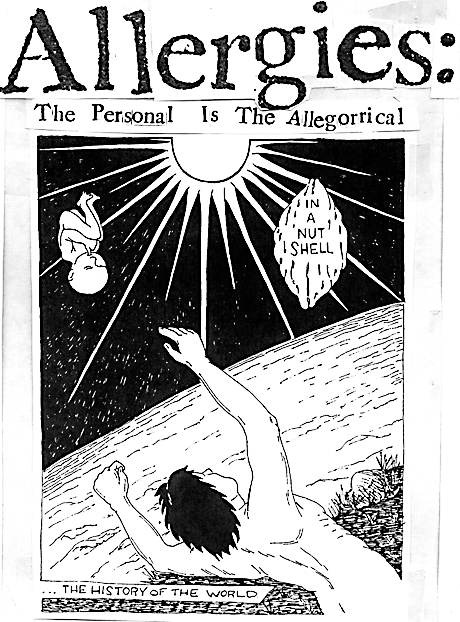|
For 30-some years I lived without allergies. I was very proud of my allergy-free status, gloating to friends, family, and co-workers, "I have never had an allergy." I imagined that they looked at me with great admiration. Such a robust and manly soul was I—always on the go, never an allergy.
I began working at a big auction house in the big city, in the department specializing in rare books, manuscripts and maps. I was enthusiastic about that job. Handling all those Henry Miller and James Joyce first editions, not to mention the old books. Pigskin Bibles, elegantly antiquated histories, classics, and everything from Erasmus to Dante. We had all the 20 pounders from the 1500s, in Latin, German, English, Hebrew, too, with engravings that look like Michaelangelos.
The little gems were just as much of a hoot. I took great pleasure in describing to my friends an exquisite little book of hours—a hand written manuscript—from the 1300s. Every page of gothic text contained a mistake. An "A" written over an "O," a "T" written over a "V" and so forth. The more I looked at the thing, the more it fascinated me. I had discovered the famous "Fuck-up Monk" of Brittany. I imagined this poor soul slaving away at the monastery for months. Perhaps a page a day. Wiping off mistakes then having to dab his cloth carefully between "good" lines of text to sop up smeared ink. I thought of the poor goat or bull or cat that was slaughtered, skinned, stretched, bathed in lime solution so it's inner skin would peel from it's rough, leathery outer skin in order to make nice, smooth pages of vellum. All so that the Fuck-up Monk could turn it into a minor atrocity. It was estimated to sell for $2,000. But think about it: $2,000 for limed flesh, the months of labor, and the centuries of preservation. Just the thought of $2,000 for, say, 4 months labor, comes to about a dime an hour—and that's not even adjusting for inflation.
We had lovely, if not fictitious maps by the Dutch map maker Blaeu, depicting great inlets and harbors in far away places with graceful curvature, enticing Dutch youth to venture across seas chock full of monsters and mermaids, even insisting California was an Island, with perfect authority. But, as the years went by, cartography became a more accurate science, and with that it revealed the earth's rough, awkward crevices with great accuracy. California was no longer an island, but part of a conquerable continent. The planet now seemed to be a patient strapped to a gurney by invisible latitudinal and longitudinal ropes. "Wipe the patient down for surgery, nurse Cratchet!"
|
 |
We knew exactly where to find the vitals and commenced to extract gold, harvest tobacco, round up the world's glorious beasts into farms, people into factories. All very enterprising, but far too depressing to think it progress.
At the Frick Museum I looked at Claude Lorrain's landscape depicting the sermon on the mount. The land is part rocky and rugged and part green and lush. The people make paths through the bushes in order to get a glimpse of their Savior, but it is clear nature is stronger. Under muscular, bushy trees, Jesus' faithful masses playfully wreak havoc on the land by mobbing it, but mother earth has unlimited strength. Her friends the trees adorn her with bright, bushy leaves that taper away into the azure sky from solid viney trunks. Magnificent marble-like stones jut from the hillsides, others like pearls line trails patted with cosmetically pleasing powder winding into valleys speckled with color. The earth is the most beautiful living, breathing soul. The larger soul that cradles all the smaller souls in a warm embrace. Ah, but that was then.
Last summer in the Olympia Forest in Washington we drove through mile after mile of fantastic 300 foot evergreens. Too often, we passed 100 acre tracts of bareness, sold to the timber industry ages ago, and since stripped for timber. They posted signs in tracts that had started reforesting cleared lots. Sites that were cleared, then replanted in, say, the 1940s now boasted 80 or 90 foot trees. Sites planted in the 20s perhaps 100 feet. It takes centuries for those trees to grow into their glorious selves, but industry deprives them of that glory.
While blowing my nose this week, my boss mentioned to me that I caught a cold every time we had a sale. Then someone on the phone said I sounded funny. I told them about my "cold" and they said, "You know, old books have spores." I know. I knew that. They didn't have to tell me. I was blocking out, but it's true. Before every sale, I spend a week reshelving books into lot order, kicking large quantities of dust particles around the room. Spores that have probably not seen the light of day in this century become airborne, and no doubt find their way into my warm, moist bosom. Clearly, I don't have a cold, I have allergies. Gimpy, sickly, limp-wristed, whiny, dweeby little allergies. Me, Joe Maynard: The Allergic Guy. Me, Joe Maynard, the writer who is allergic to books. Like the plight of great mother earth, tiny parasitic ne'er-do-wells excavate bile from my lungs, making me quake, robbing my peace. Pity me in my weakness.
You know, I've only had one cavity?
|